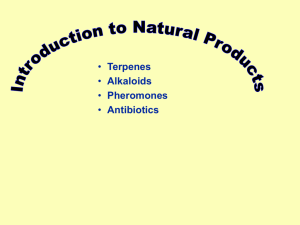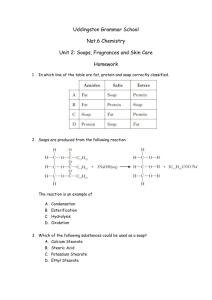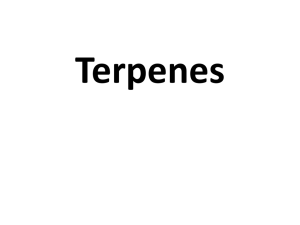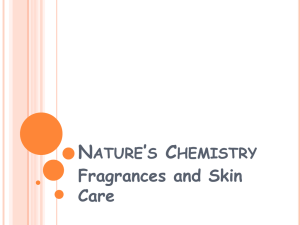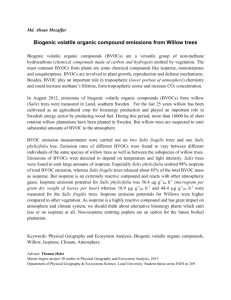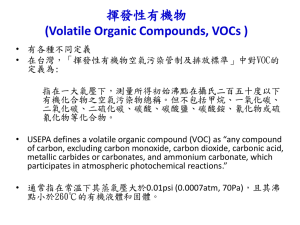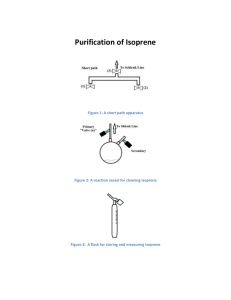Terpenes - ids
advertisement
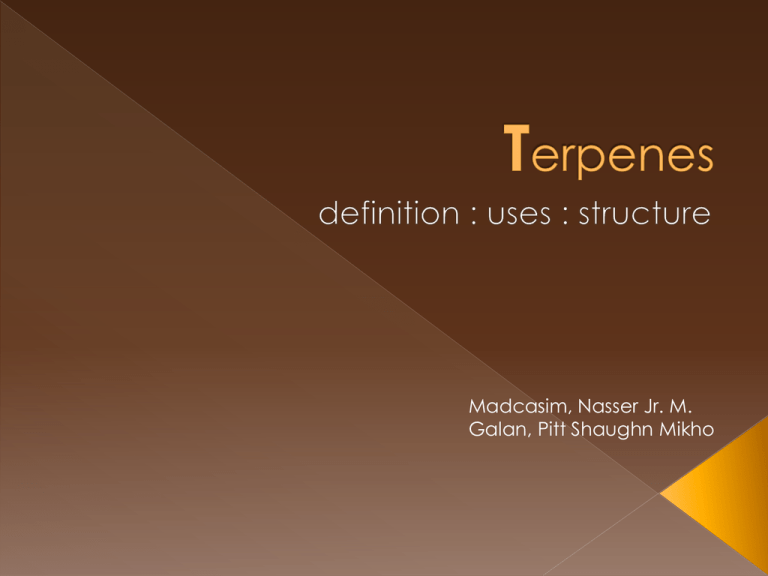
Madcasim, Nasser Jr. M. Galan, Pitt Shaughn Mikho Terpenes are a large and varied class of hydrocarbons that typically contain either ten or fifteen carbon atoms built from a five-carbon building block called isoprene . isoprene Naturally occuring hydrocarbons plants, insects , and animals. produced by These molecules are volatile —they tend to evaporate relatively easily—which allows them to reach one's nose and trigger the olfactory senses. They are the major components of resin, and of turpentine produced from resin. The name "terpene" is derived from the word "turpentine”. Terpenes commonly occur in the oils that give plants their fragrance (essential oils). Originally the term terpene was resricted to hydrocarbons, it is now used to include substituted derivatives too. Fragrances and perfumes Food Additives Insecticides Aroma Therapy Medicines Cleaning Products Terpenes are derived biosynthetically from units of isoprene, which has the molecular formula C5H8. The isoprene is the fundamental building block of terpenes isoprene In their structures, isoprene units are joined together head-to-tail. That is, C1 of the four-carbon chain of one isoprene unit is joined to C4 of another. See, for example, the structure of βselenine, below, which is made up of 3 isoprene units. Isoprene Rule (C5 Rule) The basic molecular formula of terpenes are multiples of that, (C5H8)n where n is the number of linked isoprene units. Can be linked head to tail in linear chains or rings. - consist of a single isoprene unit. Prenol, or 3-methyl-2-buten-1-ol, is a natural alcohol. It is one of the most simple terpenes. It is a clear colorless oil that is reasonably soluble in water and miscible with most common organic solvents. It has a fruity odor and is used occasionally in perfumery. Geraniol is a monoterpenoid and an alcohol. It is the primary part of rose oil, palmarosa oil, and citronella oil Java type. Limonene is a colourless liquid hydrocarbon classified as a cyclicterpene possessing a strong smell of oranges. It is used in chemical synthesis as a precursor to carvone and as a renewably-based solvent in cleaning products. - -consist of three soprene units and have the molecular formula C15H24. - The sesqui- prefix means one and a half. It is the building block of most, and possibly all, acyclic sesquiterpenoids and is an important starting compound for organic synthesis. - are composed for four isoprene units and have the molecular formula C20H32. - They are derived from geranylgeranyl pyrophosphate - They are known to be antimicrobial and anti-inflammatory. Cafestol is a diterpene molecule present in coffee. Cembrene A, or sometimes neocembrene, is a natural monocyclic diterpene isolated from corals of the genus Nephthea. It is a colorless oil with a faint wax-like odor. Cembrene A itself has little importance as chemical entity, being a trail pheromonefor termites; however, the chemical structure of cembrene is central to a very wide variety of other natural products found both in plants and in animals. Cembrenes are biosynthesized by macrocyclization of geranylgeranyl pyrophosphate. -Terpenes having 25 carbons and five isoprene units, are rare relative to the other sizes. - The sester- prefix means half to three, i.e. two and a half. -consist of six isoprene units and have the molecular formula C30H48. Farnesyl pyrophosphate FPP is an intermediate in the HMG-CoA reductase pathway used by organisms in the biosynthesis of terpenes, terpenoids, and sterols. Lanosterol is a tetracyclic triterpenoid, which is the compound from which all steroids are derived. - contain eight isoprene units and have the molecular formula C40H64. Lycopene is a bright red carotene and carotenoid pigment and phytochemical found in tomatoes and other red fruits and vegetables, such as red carrots, watermelons and papayas but not strawberries or cherries. Although lycopene is chemically a carotene, it has no vitamin A activity. Carotene is an orange photosynthetic pigmentimportant for photosynthesis. Carotenes are all coloured to the human eye. They are responsible for the orange colour of the carrot, for which this class of chemicals is named, and for the colours of many other fruits and vegetables for example, sweet potatoes and orange cantaloupe melon. - consist of long chains of many isoprene units - Natural rubber consists of polyisoprene in which the double bonds are cis. - Some plants produce a polyisoprene with trans double bonds, known as gutta-percha. Chemically, gutta-percha is a polyterpene, a polymerof isoprene, orpolyisoprene, specifically trans-1,4-polyisoprene.
